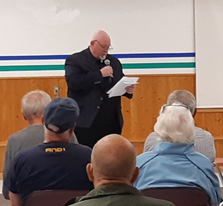
The Carleton Landowners Association (CLA) held a public meeting on Tuesday, September 24th in Stittsville.
The topic was the recent and ongoing mapping by Conservation Authorities of flood plains in rural Ottawa.
This recent round of mapping is Phase Three – two of the City’s Conservation Authorities (CAs) have been asked to do the maps of a number of waterways including creeks. The maps are then sent to the City for approval and inclusion in the Official Plan and the floodplain area is zoned. The area is then under the jurisdiction of the CA and development is prohibited. The CAs continue to act as though they also have jurisdiction over the offset areas surrounding the floodplain area and will insist that development will not be permitted in these areas without a geo-technical report (at the property owners’ expense).
The CLA was contacted by property owners affected by mapping on Harwood Creek (Mississippi Valley Conservation Authority), Flowing Creek and Hobbs Drain as well as Beckett’s Creek (Rideau Valley Conservation Authority). In all cases, in appears that the CAs are not considering the historic knowledge of the property owners nor are they acknowledging errors in the computer models used to produce the maps.
Shawn Carmichael, a drainage superintendent, pointed out the opposing interests of CAs (wetlands and floodplains) and the importance of proper drainage. Certainly, the City appears to be turning a blind eye to flooding in Goulbourn due to development (sub-divisions, highway 7, and gravel pits).

OLA President Jeff Bogaerts, who travels extensively across Ontario, recounted examples of CAs protecting wetlands at the expense of farmers and normal farm practices. He speculated that perhaps there is an opportunity to challenge the practices of the municipalities and the CAs and their continuing restrictions on the use and enjoyment of citizens of their property.
We are reminded of Tom DeWeeses’s caution in his book “Sustainability”. “Control the water and you control life. Without water there can be no homes, towns, farming, or industry. If your goal is to change human society and dictate how it’s to be developed, then controlling every aspect of how water can be used becomes the number one tool to achieve that end.”
